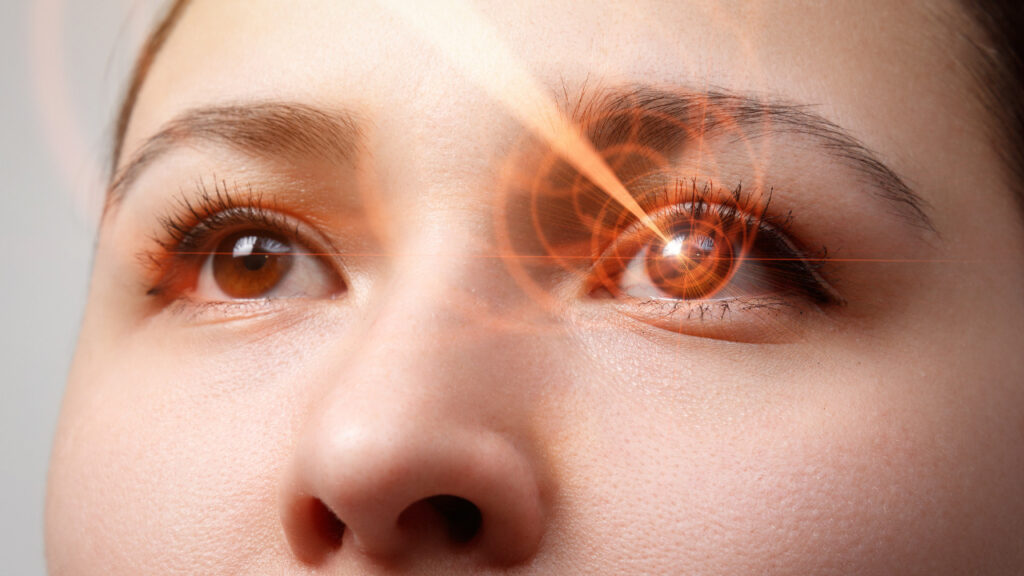Table of Contents
Exercise Daily – Do you ever wonder how far can humans see? With the various aspects that influence vision, the human eye is really capable of seeing a considerable amount of distance.
In accordance with the curvature of the Earth, and assuming you are standing on a level surface with your eyes around 5 feet above the ground, the furthest edge that you can see is approximately 3 miles distant.
It is believed that without impediments, a person with normal but not perfect eyesight may detect a candle flame from a distance of up to 1.6 miles away without using their peripheral vision.
Without the Earth’s curvature and from a greater altitude, you may be able to distinguish between things that are dozens, if not hundreds, of miles away.
What exactly happens when individuals are standing on the ground that has an impact on their ability to see a long-distance? It consists of the following
- Your vision
- Your eye health
- Size of the thing that you are looking at
- The spherical shape of the Earth
- Any impediments in your line of vision
Examine these factors to have a better understanding of how the human eye is able to perceive such great distances. This also tells how far can humans see.
Visual Acquity
The term “visual acuity” refers to the clarity with which you can see things. 20/20 eyesight is considered to be normal or good visual acuity, according to experts. Simply said, it implies that you can see something clearly from 20 feet away.

If you had 20/100 vision, you would still be able to see an item clearly from a distance of 20 feet, but someone with normal vision would be able to see it well from 100 feet away.
If you have 20/12 vision, on the other hand, you can see something clearly at 20 feet. However, the majority of others would need to be 12 feet away from it in order to see properly.
What is the process by which the eye processes images?
When you stare at anything, a quick and complicated series of activities will take place in your eyes and brain:
Cornea
The cornea is the clear outer layer of the eye. It allows light to flow through it when it reflects off of an object. The cornea distorts light rays, allowing them to pass through to the pupil. The pupil is the dark core of the eye.
Iris
Meanwhile, the muscles in the iris, which is the colorful region around the pupil, govern the size of that pupil. It helps in making it smaller in strong light and bigger in a darker environment. They also aid in how far can humans see.
Lens
The light rays next travel through the lens, which sharpens them as they reach the retina. The retina is a thin tissue layer at the back of the eye. It includes microscopic nerve cells known as rods and cones, which are responsible for seeing colors.
Rods and Cones
The rods and cones transform light rays into electrical impulses. They go from the eye to the brain where they are converted into pictures by the brain’s processing center.
As long as all of the physiological components and processes that are essential for clear vision are functioning regularly, you will be limited in your ability to see because of the following:
- Line of sight, also known as a sightline
- Light
- Size of the thing that you are now looking at
Earth’s curvature
In a theatre, the phrase “sightline” is often used to describe the line of sight that runs from a spectator’s seat to the center of the stage. A sightline, on the other hand, is any unbroken visual angle that connects a person’s eyes to the object.
The curvature of the Earth, in addition to apparent visual impediments such as trees, buildings, and clouds, is a significant element in reducing your sightline.

The Earth bends at a rate of around 8 inches every mile. Therefore, stand on a level surface with your eyes 5 feet or so above the ground. The furthest edge that you can see is about 3 miles distant while looking straight ahead. That’s exactly how far can humans see.
Another way to describe it is as follows:
Stand on a beach in Florida or drive through farmland in Nebraska. Both areas are those where the terrain is generally flat. Hence, the furthest section of the horizon that you can see is around 3 miles distant.
Angles and lines of sight are important considerations
If you were to lie down on the beach with your head no higher than a foot off the ground, your eyes would be able to see for about one mile out over the sea.
If your perspective point were considerably higher above the ground, the horizon line may seem to be much farther away. The curve of the Earth would not begin to obscure objects from your field of vision nearly so quickly.
Consider the following scenario! You were driving through Nebraska. When you came upon Scotts Bluff National Monument, you decided to go up to the 4,659-foot top.
Laramie Peak, which is about 100 miles distant in Wyoming, may be seen from this location. This is according to the National Park Service. On a clear day, you can see for miles. Although it is not infinite, it is quite a distance and this is how far can humans see.
The brightness has an effect on the distance
Consider the constellation Lyra. It contains the brightest star in the sky, Vega, which is around 25 light-years away from Earth. The constellation Vega appears in the night sky as a little candle flame. It is when seen without the use of a telescope or other visual aid.
Vega’s brightness piqued the interest of astronomers. They wondered how distant you might be from a real candle flame on Earth and yet see it.
The brightness of stars is measured in magnitudes by astronomers. A couple of Texas A&M University researchers conducted some research. They came to the conclusion that a candle flame seen from around 1,286 feet distant would have a brightness equivalent to that of Vega.
With the goal of taking their study even farther — and even beyond — the scientists conducted experiments. They discovered the greatest distance at which you could be from a candle flame and still see it.
The researchers concluded that someone with normal eyesight could identify a candle flame from around 1.6 miles away. This is providing there was no fog or other impediments.
Other factors that influence how far can humans see include the following:
The Moon’s appearance
The moon is around 238,900 miles distant. On a clear night, it is possible to view parts of its craters, valleys, and plains.

From highest peak
Even closer to home, consider the view from the top of Mount Everest in the Himalayas. It is the world’s highest peak at around 29,000 feet above sea level. It provides a panoramic vista that stretches over 211 miles in every direction, according to a user-generated map.
However, because of the height, clouds often block the view.
Skyscrapers
On a clear day, the 124th level of Dubai’s Burj Khalifa stands more than 2,700 feet tall. It is the world’s tallest structure and provides a panoramic view of almost 50 miles.
According to a report in The Daily Mail, the literal skyscraper may also present tourists with two sunsets every day on the roof.
If you get at the top of the building at the correct moment, you can view the sun sinking over the horizon. After that, you may catch the light again a little later on. Thanks to the curvature of the Earth and the incredible height of the buildings. Both of these combine to keep you gazing west.
As an illustration, consider the following scenario: If you’re flying in an aircraft at a cruising altitude of roughly 35,000 feet, you’re almost 7 miles above the surface of the Earth.
However, when it is daytime, you can readily see roads, fields, rivers, and other features if you gaze down. Nothing is in the way of your vision. And the curvature of the Earth does not prevent you from seeing any of the landmarks in the distance.
In such a case, the only actual limit to how far can humans see is the state of their eyes and the levels of visual acuity.
Nutrients That Will Optimize Your Eye Health
Vitamin A
Vitamin A insufficiency is one of the most prevalent causes of blindness in the world. This vitamin is necessary for the proper functioning of your eyes’ light-sensing cells, also known as photoreceptors, which detect light.
If you don’t get enough vitamin A in your diet, you may get night blindness, dry eyes, or even more severe problems.
Vitamin A can only be found in foods obtained from animals. Liver, egg yolks, and dairy products are some of the best dietary sources of vitamin A. It may also be found in high concentrations of vegetables such as kale, spinach, and carrots.
Lutein and Zeaxanthin
Lutein and zeaxanthin are carotenoid antioxidants that are yellow in color and are known as macular pigments. Lutein and zeaxanthin are antioxidants that act as natural sunblocks. They serve a critical function in shielding your eyes from damaging blue light.
Most of the time, lutein and zeaxanthin are found combined in meals. A few of the greatest sources are spinach, swiss chard, broccoli, kale, parsley, pistachios, and green peas.
Furthermore, egg yolks, sweet maize, and red grapes may all have significant levels of the antioxidants lutein and zeaxanthin. These can contribute to how far can humans see.
Omega-3 Fatty Acids
Omega-3 fatty acids, particularly the long-chained EPA and DHA, are essential for maintaining good eye health.
DHA is present in high concentrations in the retina, where it may be beneficial in the maintenance of eye function. It is also essential for the development of the brain and the eyes throughout the early years of life. As a result, a DHA shortage may impair eyesight.
Oily fish is the most effective dietary source of EPA and DHA. In addition, omega-3 supplements produced from fish or microalgae are commonly accessible in supplement form.
Gamma-Linolenic Acid
A fatty acid referred to as gamma-linolenic acid (GLA) is an omega-6 fatty acid. It may be found in trace levels in the contemporary diet. GLA, in contrast to a number of other omega-6 fatty acids, seems to have anti-inflammatory characteristics.
Evening primrose oil and starflower oil are the most abundant sources of gamma-linolenic acid (GLA).
Vitamin C
The concentration of vitamin C in the aqueous humor of the eye is greater than in any other bodily fluid. The aqueous humor is the clear liquid that covers the outermost region of your eyeball and surrounds the lens.
The levels of vitamin C in the aqueous humor are directly proportional to its dietary intake. In other words, taking vitamin C pills or consuming meals high in vitamin C may help you raise its concentration.
The vitamin C content in a wide variety of fruits and vegetables is particularly high, including bell peppers, citrus fruits, guavas, kale, and broccoli.
Vitamin E
It is a member of the vitamin E family of fat-soluble antioxidants. They protect fatty acids from the damaging effects of oxidation. Because your retina has a high concentration of fatty acids, ensuring that you get enough vitamin E is essential for maintaining good eye health.
Almonds, sunflower seeds, and vegetable oils such as flaxseed oil are some of the greatest dietary sources of vitamin E.
Also read: Vitamins for Restless Legs
Zinc
Zinc is found in significant concentrations in your eyes. Several important enzymes, including superoxide dismutase, which has antioxidant properties, have zinc as an inorganic component.
It also seems to be involved in the production of visual pigments in your retina, which is a fascinating development. They aid in how far can humans see. As a result, a zinc shortage may result in night blindness in certain people.
Oysters, pumpkin seeds, and peanuts are all good sources of zinc in the natural world of food.
Take Away
Healthy lifestyle practices, such as eating a well-balanced diet and getting enough exercise, may help avoid a variety of chronic illnesses, including eye problems.
Getting enough of the nutrients mentioned above may help lower your chance of developing eye disease. Other vitamins, in addition to vitamin A, may have an impact on eye health. Don’t forget to take care of the rest of your body as well.
A diet that promotes overall health will almost certainly promote overall health in your eyes as well. Share your healthcare routine in the comments section below.













